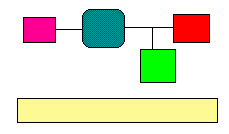When reading the newspaper or browsing the internet I tend to be drawn to articles in which someone is developing a solution to a widespread (or at least widely talked about) problem.
Recent stories that come to mind focused on faith-based financial education as a way to help individuals increase financial discipline, the recent announcement by the Broad and Gates foundations of a major investment in increasing the American dialog for education (and ultimately to ensure more students go on to postsecondary education) and the large investment by the Robert Wood Johnson Foundation to fight childhood obesity.
These stories interest me because I am fascinated with how people define problems or needs and then develop strategies to solve them. In our work with clients we often use an approach called logic modeling. (You can find somewhat academic background articles about logic models here and here). When we first suggest developing a logic model to a client, we try to emphasize that it isn't an intimidating process, although it can take considerable time and effort to get it right. We describe logic models as a simple, visual way to describe (1) what you hope to accomplish, (2) who or what is expected to change, (3) through what efforts and (4) why the effort is important. They can take many forms; we recently created a bulls eye-shaped logic model for City House that started out as a diagram of a person; another logic model of collaboration (see a blog about our presentation to Minnesota Superintendents) took a much more traditional flow-chart format.
 Logic models get tweaked periodically as the environment and programs evolved. For example, in our Safe Schools/Healthy Students evaluation work with Spring Lake Park District 16 over a 4-year period, we revisited the logic model twice, with the final version most strongly representing the unique characteristics of the districts in the context of the federal program.
When I hear of new initiatives, abbreviated logic models are the easiest way for me to understand what is happening. Sometimes before I realize it, I have created a mental diagram of the changes a program is expecting and through what initiatives. I am not sure if this is common to other people who do evaluation work, but is the primary frame for the way I look at private and public efforts to improve the public good.
Logic models get tweaked periodically as the environment and programs evolved. For example, in our Safe Schools/Healthy Students evaluation work with Spring Lake Park District 16 over a 4-year period, we revisited the logic model twice, with the final version most strongly representing the unique characteristics of the districts in the context of the federal program.
When I hear of new initiatives, abbreviated logic models are the easiest way for me to understand what is happening. Sometimes before I realize it, I have created a mental diagram of the changes a program is expecting and through what initiatives. I am not sure if this is common to other people who do evaluation work, but is the primary frame for the way I look at private and public efforts to improve the public good.
 Logic models get tweaked periodically as the environment and programs evolved. For example, in our Safe Schools/Healthy Students evaluation work with Spring Lake Park District 16 over a 4-year period, we revisited the logic model twice, with the final version most strongly representing the unique characteristics of the districts in the context of the federal program.
When I hear of new initiatives, abbreviated logic models are the easiest way for me to understand what is happening. Sometimes before I realize it, I have created a mental diagram of the changes a program is expecting and through what initiatives. I am not sure if this is common to other people who do evaluation work, but is the primary frame for the way I look at private and public efforts to improve the public good.
Logic models get tweaked periodically as the environment and programs evolved. For example, in our Safe Schools/Healthy Students evaluation work with Spring Lake Park District 16 over a 4-year period, we revisited the logic model twice, with the final version most strongly representing the unique characteristics of the districts in the context of the federal program.
When I hear of new initiatives, abbreviated logic models are the easiest way for me to understand what is happening. Sometimes before I realize it, I have created a mental diagram of the changes a program is expecting and through what initiatives. I am not sure if this is common to other people who do evaluation work, but is the primary frame for the way I look at private and public efforts to improve the public good.
